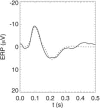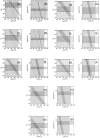Estimation of multiscale neurophysiologic parameters by electroencephalographic means
- PMID: 15281141
- PMCID: PMC6871818
- DOI: 10.1002/hbm.20032
Estimation of multiscale neurophysiologic parameters by electroencephalographic means
Abstract
It is shown that new model-based electroencephalographic (EEG) methods can quantify neurophysiologic parameters that underlie EEG generation in ways that are complementary to and consistent with standard physiologic techniques. This is done by isolating parameter ranges that give good matches between model predictions and a variety of experimental EEG-related phenomena simultaneously. Resulting constraints range from the submicrometer synaptic level to length scales of tens of centimeters, and from timescales of around 1 ms to 1 s or more, and are found to be consistent with independent physiologic and anatomic measures. In the process, a new method of obtaining model parameters from the data is developed, including a Monte Carlo implementation for use when not all input data are available. Overall, the approaches used are complementary to other methods, constraining allowable parameter ranges in different ways and leading to much tighter constraints overall. EEG methods often provide the most restrictive individual constraints. This approach opens a new, noninvasive window on quantitative brain analysis, with the ability to monitor temporal changes, and the potential to map spatial variations. Unlike traditional phenomenologic quantitative EEG measures, the methods proposed here are based explicitly on physiology and anatomy.
Copyright 2004 Wiley-Liss, Inc.
Figures











Similar articles
-
Multiscale brain modelling.Philos Trans R Soc Lond B Biol Sci. 2005 May 29;360(1457):1043-50. doi: 10.1098/rstb.2005.1638. Philos Trans R Soc Lond B Biol Sci. 2005. PMID: 16087447 Free PMC article.
-
Monte Carlo simulation studies of EEG and MEG localization accuracy.Hum Brain Mapp. 2002 May;16(1):47-62. doi: 10.1002/hbm.10024. Hum Brain Mapp. 2002. PMID: 11870926 Free PMC article.
-
Real-time automated EEG tracking of brain states using neural field theory.J Neurosci Methods. 2016 Jan 30;258:28-45. doi: 10.1016/j.jneumeth.2015.09.026. Epub 2015 Oct 31. J Neurosci Methods. 2016. PMID: 26523766
-
Mining event-related brain dynamics.Trends Cogn Sci. 2004 May;8(5):204-10. doi: 10.1016/j.tics.2004.03.008. Trends Cogn Sci. 2004. PMID: 15120678 Review.
-
Clinical neurophysiologic monitoring and brain injury from cardiac arrest.Neurol Clin. 2006 Feb;24(1):89-106. doi: 10.1016/j.ncl.2005.11.003. Neurol Clin. 2006. PMID: 16443132 Review.
Cited by
-
Dynamic causal modelling of lateral interactions in the visual cortex.Neuroimage. 2013 Feb 1;66:563-76. doi: 10.1016/j.neuroimage.2012.10.078. Epub 2012 Nov 2. Neuroimage. 2013. PMID: 23128079 Free PMC article.
-
Time-Based Binding as a Solution to and a Limitation for Flexible Cognition.Front Psychol. 2022 Jan 24;12:798061. doi: 10.3389/fpsyg.2021.798061. eCollection 2021. Front Psychol. 2022. PMID: 35140662 Free PMC article.
-
Dynamic causal modeling with neural fields.Neuroimage. 2012 Jan 16;59(2):1261-74. doi: 10.1016/j.neuroimage.2011.08.020. Epub 2011 Sep 5. Neuroimage. 2012. PMID: 21924363 Free PMC article.
-
Anesthetic action on the transmission delay between cortex and thalamus explains the beta-buzz observed under propofol anesthesia.PLoS One. 2017 Jun 16;12(6):e0179286. doi: 10.1371/journal.pone.0179286. eCollection 2017. PLoS One. 2017. PMID: 28622355 Free PMC article. Clinical Trial.
-
The emergence of synchrony in networks of mutually inferring neurons.Sci Rep. 2019 Apr 30;9(1):6412. doi: 10.1038/s41598-019-42821-7. Sci Rep. 2019. PMID: 31040386 Free PMC article.
References
-
- Barrionuevo G, Benoit O, Tempier P (1981): Evidence for two types of firing pattern during the sleep‐waking cycle in the reticular thalamic nucleus of the cat. Exp Neurol 72: 486–501. - PubMed
-
- Braitenberg V, Schüz A (1998): Cortex: statistics and geometry of neuronal connectivity (2nd ed). Berlin: Springer.
Publication types
MeSH terms
LinkOut - more resources
Full Text Sources

